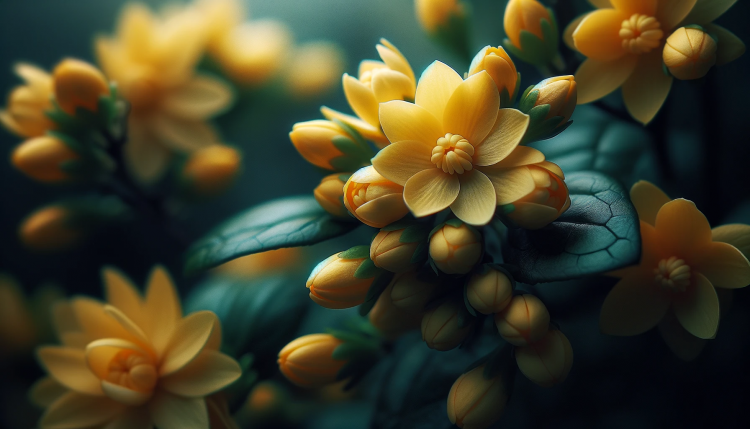
Winter Jasmine (Jasminum nudiflorum), with its bright yellow flowers, is a beacon of cheer in the cold winter months. This hardy shrub is known for its resilience and the burst of color it brings to gardens when most plants are dormant. In this blog post, we’ll delve into everything about Winter Jasmine – from its origins to care tips, and its role in the garden landscape.
Origins and Characteristics
Winter Jasmine is native to China and was introduced to Western gardens in the mid-19th century. It’s a deciduous shrub that typically grows to about 4 feet tall and spreads up to 7 feet wide. Its arching branches give it a fountain-like appearance, and it’s often used in cascading over walls or in elevated planters.
The Winter Bloomer
One of the most remarkable features of Winter Jasmine is its blooming time. Unlike most plants, it flowers in winter or very early spring, depending on the climate:
- Flowers: The flowers are small, bright yellow, and star-shaped, appearing before the leaves.
- Timing: Blooming typically occurs in January or February in the Northern Hemisphere.
Planting and Growing Conditions
Winter Jasmine is not particularly fussy about conditions and is relatively easy to grow:
- Soil: It thrives in well-drained soil and is tolerant of a range of soil types.
- Sunlight: It prefers full sun but can tolerate partial shade.
- Planting: Ideal for planting as ground cover, on slopes for erosion control, or in containers.
Care and Maintenance
While low-maintenance, Winter Jasmine does benefit from some basic care:
- Watering: Regular watering is important, especially during dry spells. However, the plant is drought-tolerant once established.
- Pruning: Pruning after flowering helps maintain its shape and encourages more prolific blooming the following season.
- Fertilizing: A balanced, slow-release fertilizer can be applied in the spring.
Propagation
Propagating Winter Jasmine is relatively straightforward:
- Cuttings: Take cuttings in the summer, root them in potting soil, and keep them moist until they establish.
Pests and Diseases
Winter Jasmine is remarkably resistant to pests and diseases, but keep an eye out for common issues such as:
- Aphids: These can occasionally be a problem but are usually controlled naturally or with insecticidal soap.
- Root Rot: Avoid overwatering to prevent root rot.


Landscape Uses and Design Ideas
Winter Jasmine’s versatility makes it a valuable plant in garden design:
- Wall and Fence Cover: Its cascading habit makes it ideal for growing over walls or fences.
- Ground Cover: It can be used to cover bare patches in the garden, especially on slopes or banks for erosion control.
- Winter Garden Accent: Its bright yellow flowers provide a stunning contrast in winter gardens, often dominated by bare branches and muted colors.
Winter Jasmine in Folklore and Aromatherapy
While Winter Jasmine is not as fragrant as some of its jasmine relatives, it still holds a place in folklore and aromatherapy:
- Symbolism: In various cultures, jasmine is a symbol of beauty, love, and purity.
- Aromatherapy: Although Winter Jasmine has a milder scent, it is sometimes used in aromatherapy for its uplifting and soothing properties.
Benefits for Wildlife
Winter Jasmine is not just a delight for humans; it also provides benefits for wildlife:
- Early Nectar Source: Its early blooms provide a valuable nectar source for bees and other pollinators at a time when few other flowers are available.
- Shelter: The dense foliage offers shelter for birds and small wildlife.
Incorporating Winter Jasmine in Holiday Decor
The bright blooms of Winter Jasmine can also be incorporated into holiday decor:
- Fresh Cuttings: Branches with blooms can be used in floral arrangements or as part of wreaths and garlands.
- Indoor Decor: Smaller plants can brighten indoor spaces during the holiday season.
Care Tips for Different Climates
Adapting care for Winter Jasmine in various climates is important for its success:
- Colder Climates: In regions with harsh winters, it may need protection from extreme cold.
- Warmer Climates: In areas with milder winters, Winter Jasmine may bloom even earlier and require less winter protection.
Winter Jasmine is more than just a pretty face in the winter garden; it’s a plant of resilience, versatility, and cheer. Its ease of care, coupled with the beauty it brings to the often bleak winter landscape, makes it a favorite among gardeners. Whether used in landscaping, as a source of early nectar for wildlife, or in holiday decorations, Winter Jasmine’s bright yellow blooms are a welcome sight in the cold months, reminding us that beauty thrives even in the most unexpected conditions.





